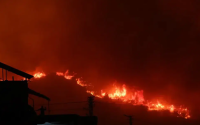September 1, 2010
In the late 1870s, a series of droughts and famines devastated a broad swath of the globe, including what is now Pakistan. The 1876-78 drought killed 6 million people in India; in China, 12 million people died of starvation and disease. Many millions more were plunged into agonizing poverty. The story of the famines and their connection to extreme weather are the subject of a 2001 book by University of Southern California professor Mike Davis, entitled Late Victorian Holocausts: El Nino Famines and the Making of the Third WorldIn the late 19th century, El Nino cycles were not understood. Today, the world is witnessing the accelerating pattern of extreme weather events, like the floods that have engulfed Pakistan.
What Davis tells us is that the suffering and deaths that occurred were not caused by weather but the colonial and free trade policies of Europe, the U.S. and Japan. In the midst of mass starvation in India, basic food exports continued to flow to England. As whole communities perished, Indian peasants were taxed to pay for British wars against Afghanistan. British policies in India were predicated on the population theories of Thomas Robert Malthus, who was employed by the British East India Company—too many people, too little land, too little food—a description better suited to England.
Today, the flood victims in Pakistan were poor and hungry before the rain started to fall and the rivers and canals overflowed their banks. It is estimated that over 60 percent of the population of Pakistan lives on under $2.00 a day. For many years after partition from India, Pakistan was making strides in its development, but the combination of military dictatorships, corrupt governments and Cold War proxy wars (and now counter-terrorism campaigns) have left Pakistani peasants destitute and under siege.
What is new—and what was unknown at the end of the 19th century—was that the industrial system, then in its infancy, would lead to global warming and extreme weather events. From Katrina to the overflowing Moscow morgues, the industrial model that causes extreme weather is also responsible for exhausting the people, land and resources of the world. When the two meet the consequences are disastrous.






